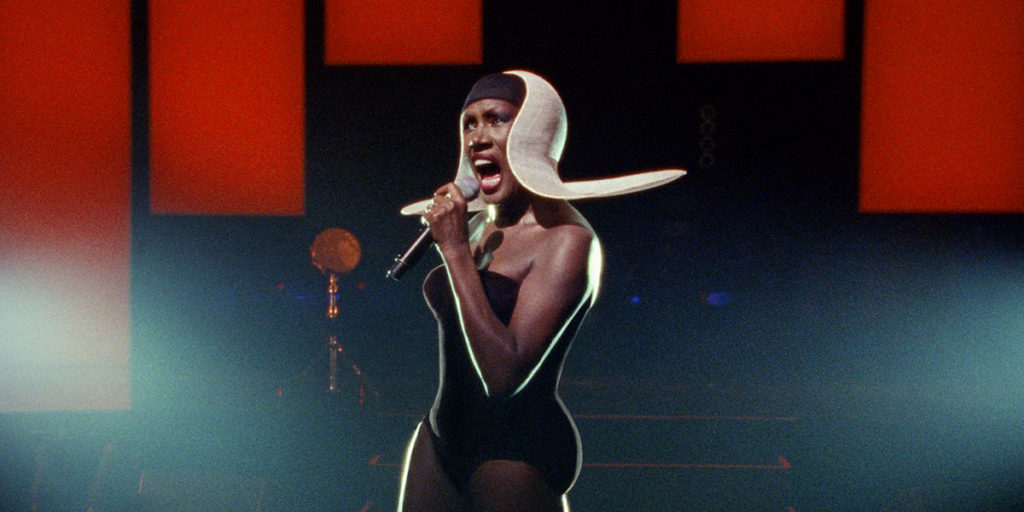
Grace Jones is a pioneer, an androgynous model who became a singer, actress and performance artist all rolled up into one. She well deserves a comprehensive biofilm, one that her fans can appreciate and new admirers can adore.
This unique, 10-year in the making slice-of-life documentary may not be what her most ardent followers crave. But it’s something.
Born in Jamaica (1949) and raised outside of Syracuse, New York, she was a shy, repressed daughter of a Pentecostal minister. It was no wonder that Grace rebelled—big time. By the 1960s she lived in a New York City hippie commune, was as a go-go-dancer and heralded the effects of LSD. A blossoming model career took her to Paris in the ‘70s, where she did runway for Yves St. Laurent, appeared on the cover of Vogue and was roommates with fellow mannequins Jerry Hall and Jessica Lang.
Jones short hair, bright lipstick and post-modern, futuristic clothes made her popular with the paparazzi and an alluring spectacle, both on and off the runway. A distinctive singing career followed with her eclectic blend of club music, rock and soul (“La Vie en Rose,” “Love is the Drug,” “Nightclubbing”). Acting gigs ensued (Conan the Destroyer, A View to a Kill, Boomerang). Romances with Dolph Lundgren and her partner/photographer Jean-Paul Goude, slapping a British talk show host on live TV and being notoriously late for gigs further stirred her pot of controversy and legend. It’s important for us to put her breakthroughs, insights, achievements and media storms into perspective. Why? Because, this short-sighted film never does.
Instead, documentarian Sophie Fiennes (The Pervert’s Guide to Cinema) prefers an unconventional creative strategy. In Grace Jones: Bloodlight and Bami, viewers will not screen poignant archival footage. They won’t discover her deepest darkest secrets or witness informative interviews. Nor will they learn about Jones’s impressive stats: Grammy and MTV Video Award Nominations, #1 Billboard Club Music hits like “Pull Up to the Bumper”and she’s been dubbed the 40thmost successful dance artist of all time.
This enigmatic, cinema verité look at Ms. Jones (five years’ worth of filming, five years in postproduction) plays more like an extended reality show than a biodoc. The filmmaking is intrusive, and you never feel like the camera is an inconspicuous fly on the wall. It’s as if Grace is looking in the mirror, never in a natural, guard-down state. Think Real Housewives of Atlanta, but then subtract the extreme highs and lows.
A 2016 concert demonstrates that Jones hasn’t lost much of her snarl or bewitching charm. Watching her use costumes and lighting as an integral part of her act, reminds us that back in the day she set worldwide fashion and performance art trends (à la David Bowie).
She is also photographed in the midst of recording her 2008 studio album Hurricane, with longtime music friends Sly Dunbar and Robbie Shakespeare. The new music further extends her very strong-willed persona with lyrics from the title song that go: “I am woman. I am sun. I can give birth to she. I can give birth to son. And I can be cool. Soft as the breeze. I’ll be a hurricane. Ripping up trees!”
Scenes shot in Jamaica depict Grace in church, the place she rebelled from for so many years. This is when Remko Schnorr’s evocative cinematography catches traction. Pastoral shots of deep green landscapes look like paradise. Glimpses of the musician’s mother singing are framed like a family portrait. At times Jones looks at home. At times completely uncomfortable, and the ambivalence on her face is captured by the lens, in detail. These few moments in the footage, knowing the trajectoryof hermild to wild life, seem the most emotionally bare. It’s as if we are watching the last chapter in her cycle, and her exodus includes making amends with her past.
“Bloodlight” refers to the studio signal for recording. “Bami” is a Jamaican flatbread. The title of this non-fiction film seems to sum up the dichotomy that is so Grace Jones.
Even as she approaches age 70, and within the confines of this very uncomprehensive format, it’s still easy to see that the timid preacher’s daughter grew into a hurricane that’s ripping up trees.
Visit NNPA News Wire Film Critic Dwight Brown at DwightBrownInk.com.